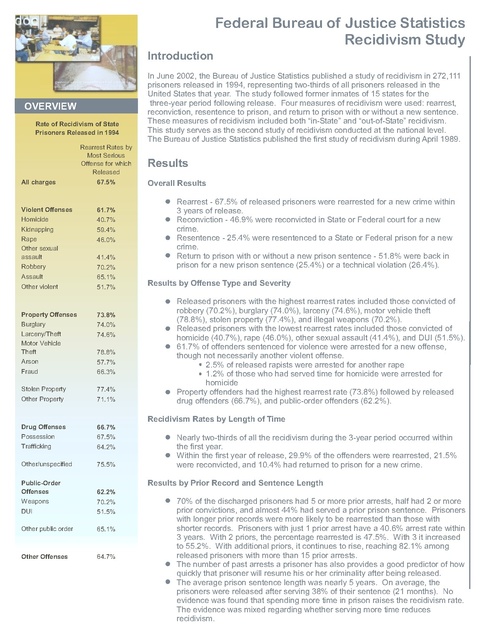Usdoj Recidivism Study 1994
Download original document:

Document text

Document text
This text is machine-read, and may contain errors. Check the original document to verify accuracy.
Introduction OVERVIEW Rate of Recidivism of State Prisoners Released in 1994 Rearrest Rates by Most Serious Offense for which Released All charges 67.5% Violent Offenses Homicide 61.7% Kidnapping 59.4% Rape Other sexual assault 46.0% Robbery 70.2% Assault 65.1% Other violent 51.7% 40.7% 41.4% Property Offenses Burglary 73.8% Larceny/Theft Motor Vehicle Theft 74.6% Arson 57.7% Fraud 66.3% Stolen Property 77.4% Other Property 71.1% Drug Offenses Possession 66.7% Trafficking 64.2% Other/unspecified 75.5% Public-Order Offenses Weapons 62.2% DUI 51.5% Other public order 65.1% Other Offenses 64.7% 74.0% 78.8% 67.5% 70.2% Federal Bureau of Justice Statistics Recidivism Study In June 2002, the Bureau of Justice Statistics published a study of recidivism in 272,111 prisoners released in 1994, representing two-thirds of all prisoners released in the United States that year. The study followed former inmates of 15 states for the three-year period following release. Four measures of recidivism were used: rearrest, reconviction, resentence to prison, and return to prison with or without a new sentence. These measures of recidivism included both in-State and out-of-State recidivism. This study serves as the second study of recidivism conducted at the national level. The Bureau of Justice Statistics published the first study of recidivism during April 1989. Results Overall Results Rearrest - 67.5% of released prisoners were rearrested for a new crime within 3 years of release. Reconviction - 46.9% were reconvicted in State or Federal court for a new crime. Resentence - 25.4% were resentenced to a State or Federal prison for a new crime. Return to prison with or without a new prison sentence - 51.8% were back in prison for a new prison sentence (25.4%) or a technical violation (26.4%). Results by Offense Type and Severity Released prisoners with the highest rearrest rates included those convicted of robbery (70.2%), burglary (74.0%), larceny (74.6%), motor vehicle theft (78.8%), stolen property (77.4%), and illegal weapons (70.2%). Released prisoners with the lowest rearrest rates included those convicted of homicide (40.7%), rape (46.0%), other sexual assault (41.4%), and DUI (51.5%). 61.7% of offenders sentenced for violence were arrested for a new offense, though not necessarily another violent offense. 2.5% of released rapists were arrested for another rape 1.2% of those who had served time for homicide were arrested for homicide Property offenders had the highest rearrest rate (73.8%) followed by released drug offenders (66.7%), and public-order offenders (62.2%). Recidivism Rates by Length of Time Nearly two-thirds of all the recidivism during the 3-year period occurred within the first year. Within the first year of release, 29.9% of the offenders were rearrested, 21.5% were reconvicted, and 10.4% had returned to prison for a new crime. Results by Prior Record and Sentence Length 70% of the discharged prisoners had 5 or more prior arrests, half had 2 or more prior convictions, and almost 44% had served a prior prison sentence. Prisoners with longer prior records were more likely to be rearrested than those with shorter records. Prisoners with just 1 prior arrest have a 40.6% arrest rate within 3 years. With 2 priors, the percentage rearrested is 47.5%. With 3 it increased to 55.2%. With additional priors, it continues to rise, reaching 82.1% among released prisoners with more than 15 prior arrests. The number of past arrests a prisoner has also provides a good predictor of how quickly that prisoner will resume his or her criminality after being released. The average prison sentence length was nearly 5 years. On average, the prisoners were released after serving 38% of their sentence (21 months). No evidence was found that spending more time in prison raises the recidivism rate. The evidence was mixed regarding whether serving more time reduces recidivism. 1 Results by Demographic Characteristics Men were more likely to be rearrested (68.4%) than women (57.6%), blacks (72.9%) more likely than whites (62.7%), and non-Hispanics (71.4%) more likely than Hispanics (64.6%). Younger prisoners were more likely to be rearrested than older ones. Over 80% of those under age 18 were rearrested, compared to 45.3% of those 45 and older. Number of Crimes Committed The 67.5% (N = 183,675) of releases rearrested were charged with 744,480 new crimes, an average of 4 new crimes each. More than 100,500 of these new charges were for violent offenses. Results by Location An estimated 7.6% of all released prisoners were rearrested for a new crime in a State other than the one that released them. Of the 744,480 new charges during the 3-year follow-up period, 688,720 were committed in the same State that released the prisoner and 55,760 were committed in other states. Comparison of Recidivism Rates for Prisoners Released in 1983 and 1994 The April 1989 BJS study examined 108,580 prisoners released from prison in 11 states for the 3-year period following their release in 1983. All 11 are among the States included in the present study. The overall rearrest rate rose significantly in the second study. 62.5% of the prisoners released in 1983 were rearrested, whereas in 1994, the figure was 67.5%. There was a significant rise from 1983 to 1994 in the rearrest rate for released property offenders, released drug offenders, and released public-order offenders. There was no increase in the rearrest rate for released violent offenders. Reconviction rates remained constant from 1983 to 1994, 46.8% and 46.9%, respectively. The only significant change in reconviction rates was the increase for drug offenders, from 35.3% in 1983 to 47.0% in 1994. The complete June 2002 report published by the Bureau of Justice Statistics, U.S. Department of Justice, Office of Justice Programs, Recidivism of Prisoners Released in 1994" is available at the BJS World Wide Web Internet site: www.ojp.usdoj.gov/bjs 2




